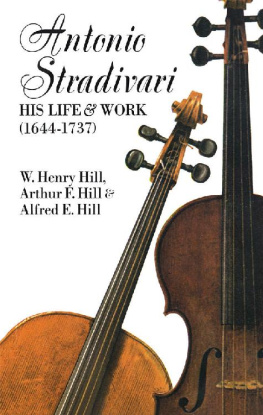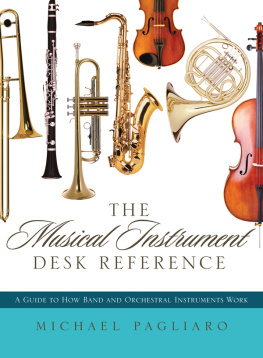Quite a number of good histories of acoustics have been written (Lindsay ). Relatively less has been written about scientific research on other string instruments.
Pythagoras, who established mathematics in Greek culture during the sixth century BC, studied vibrating strings and musical sounds. He reportedly discovered that dividing the length of a vibrating string into simple ratios produced consonant musical intervals. According to legend, he also observed how the pitch of the string changed with tension and the tones generated by striking musical glasses, but these are probably just legends (Hunt ).
Most early acoustical investigations were closely tied to musical acoustics. Galileo reviewed the relationship of the pitch of a string to its vibrating length, and he related the number of vibrations per unit time to pitch. The English mathematician Brook Taylor provided a dynamical solution for the frequency of a vibrating string based on the assumed curve for the shape of the string when vibrating in its fundamental mode. Daniel Bernoulli set up a partial differential equation for the vibrating string and obtained solutions which dAlembert interpreted as waves traveling in both directions along the string (Beyer ).
1.1.1 Bowed String Instruments
During the sixteenth century, two families of viols developed: the viola da gamba , or leg viol, and the viola da braccio , or arm viol. These instruments, which normally had six strings tuned in fourths (except for a major third separating the third and fourth strings), developed in different sizes from treble to bass. They have remained popular to this day, especially for playing music from their period and accompanying singing.
The instruments in the violin family were developed in Italy during the sixteenth and seventeenth centuries and reached a peak in the eighteenth century in the hands of masters such as Antonio Stradivari and Giuseppe Guarneri del Ges of Cremona. The viola, tuned a perfect fifth below the violin, is the alto member of the violin family. It is a distinctly different instrument, however, as is the violoncello or cello, the baritone member of the family. The double bass or contrabass, which is tuned in fourths, has mainly developed from the bass viol.
The all-important bow was given its present form by Francois Tourte (17471835). Two important characteristics of his bows are the inward curving stick of pernambuco wood and the frog with a metal ferrule to keep the bow hair evenly spread.
In his Harmonie Universelle , Marin Mersenne (14881648) discussed string instruments and indicated that he could hear at least four overtones in the sound of a vibrating string. The stick and slip action of the bow on the string appears to have been first recognized by Jean-Marie Duhamel (17971872).
Hutchins () calls Felix Savart (17911841) the grandfather of violin research. He developed a cog-wheel machine to measure frequency, and he made many tests of the vibrational characteristics of the violin and its component parts. Working with the famous violinmaker Jean Baptiste Vuillaume (17981875), Savart was able to measure the so-called tap gone frequencies in a dozen or so violins made by Antonio Stradivari and Joseph Guarneri.
Herman von Helmholtz (18211894), who was trained as a physician, contributed much to our understanding of violin science as well as to the science of hearing and perception. His book On Sensations of Tone (1862) combines his knowledge of both physiology and physics and of music as well. He worked with little more than a stringed instrument, tuning forks, and his famous resonators to show that pitch is due to the fundamental frequency but that the quality of a musical sound is due to the presence of upper partials.
In order to study vibrations of violin stings and speech sounds, von Helmholtz invented a vibration microscope, which displayed Lissajous patterns of vibration. One lens of the microscope is attached to the prong of a tuning fork, so a fixed spot appears to move up and down. A spot of luminous paint is then applied to the string, and a bow is drawn horizontally across the vertical string. The point on the horizontally vibrating violin string forms a Lissajous pattern as it moves. By viewing patterns for a bowed violin string, von Helmholtz was able to determine the actual motion of the string, and such motion is still referred to as Helmholtz motion.
John William Strutt, who was to become the third Baron Rayleigh, was born at the family estate in Terling England, in 1842. He enrolled at Eton, but illness caused him to drop out, and he completed his schooling at a small academy in Torquay before entering Trinity College, Cambridge. His ill health may have been a blessing for the rest of the world. After nearly dying of rheumatic fever, he took a long cruise up the Nile River, during which he concentrated on writing Science of Sound . The first volume of this book develops the theory of vibrations and its applications to strings, bars, membranes, and plates, while the second volume begins with aerial vibrations and the propagation of waves in fluids.
Bowed string instruments have frequently attracted the attention of scientific researchers. Outstanding contributions to our understanding of violin acoustics have been made by Felix Savart, Hermann von Helmholtz, Lord Rayleigh, C.V. Raman, Frederick Saunders, and Lothar Cremer, all of whom also distinguished themselves in fields other than violin acoustics. In more recent times, the work of Professor Saunders has been continued by members of the Catgut Acoustical Society, led by Carleen Hutchins. This work has made good use of modern tools such as computers, holographic interferometers, and FFT analyzers. One noteworthy product of modern violin research has been the development of an octet of scaled violins, covering the full range of musical performance (Hutchins ).









